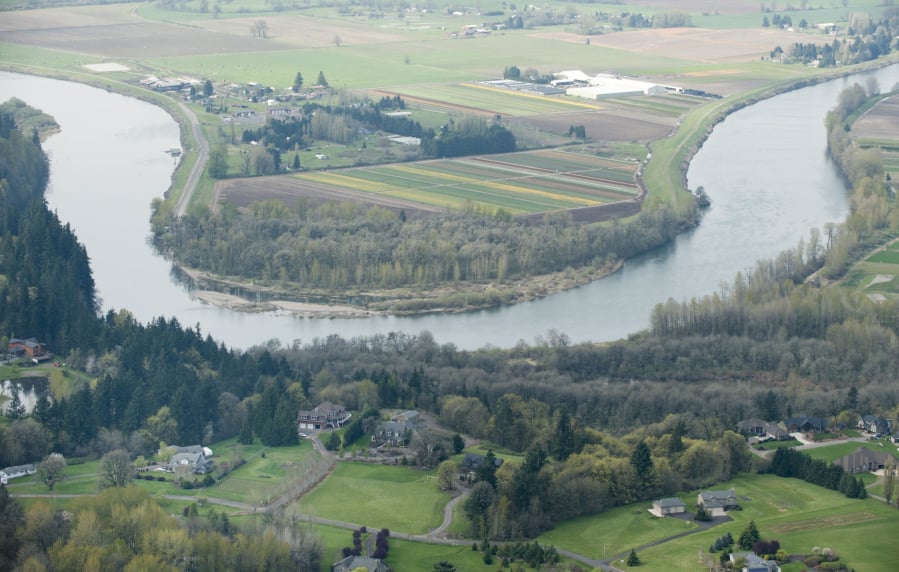The East Fork of the Lewis River has been called an environmental jewel.
In reality, that jewel has been tarnished by more than a century of human activity.
Mining, logging, farming and residential development have taken their toll on the free-flowing river. Today, the East Fork is on the Washington State Department of Ecology’s polluted waters list for elevated water temperature and fecal coliform bacteria.
The Ecology Department has scheduled a town hall meeting for 6 to 8 p.m. Monday at the La Center Grange, 328 W. Fifth St., to raise awareness, share information, answer questions and encourage property owners to support restoration efforts. The event is being hosted in partnership with Clark County Public Works, the city of La Center, Washington State University Clark County Extension, the Clark Conservation District and the Watershed Alliance of Southwest Washington.
Devan Rostorfer, an Ecology Department water quality specialist, said the meeting will be a good way for landowners to learn how they can help improve water quality.
If You Go
What: Town hall meeting on water quality in East Fork of the Lewis River.
When: 6 to 8 p.m. Monday.
Where: La Center Grange, 328 W. Fifth St.
More information on East Fork restoration:ecology.wa.gov/EastForkLewisRiver
Report Pollution
The Washington State Department of Ecology encourages residents to report pollution and other environmental issues online, ecology.wa.gov/ReportAnIssue, or by telephone, 360-407-6330.
“Our long-term goal is to support recreation and aquatic life so people can swim, fish and enjoy the East Fork Lewis River,” she said.
Ongoing restoration efforts have been bolstered by the East Fork Lewis River Partnership, a collaboration of local, state, tribal and federal governments, nonprofit organizations, watershed groups, private industries and landowners.
The partnership has been meeting since August 2018. Multiple participants are expected to attend Monday’s town hall meeting in La Center.
43.5 miles long
The East Fork tumbles from the Cascades and flows west for 43.5 miles through Skamania and Clark counties before its confluence with the North Fork west of La Center.
The river’s watershed drains about 212 square miles. More than 75 percent of the watershed is in Clark County, with the river’s upper reaches in the Gifford Pinchot National Forest in Skamania County.
Water quality problems have been long documented. In 2010, Clark County released a stream health assessment that rated three tributaries — Lockwood, Mason and McCormick creeks — as being in “poor health,” with the overall East Fork watershed in “fair health.”
Rostorfer said the county’s findings are similar to the state’s conclusions, but there is still reason for optimism.
“There are opportunities to restore and make a difference in the watershed,” she said. “It isn’t degraded to a point that it is not recoverable. There are a lot of opportunities for salmon recovery.”
Animal, human waste
Fecal coliform bacteria is from human or animal waste entering the East Fork’s watershed. Potential sources include failing septic systems and excrement from wildlife, livestock and domestic dogs and cats. Storm runoff can pick up these contaminants and carry them to the river.
Elevated water temperatures can be caused by the loss of Douglas firs and other vegetation, which shade the river and drop woody debris in its channel. Both are important to provide clean, cold water and diverse habitat salmon and steelhead need to survive and spawn.
Richard Dyrland, president of Friends of the East Fork, said mining and other activities have added sediment to the river. Sedimentation has caused the East Fork to become wider and shallower, which in turn leads to higher water temperatures, he said.
“The river has become so wide,” said Jim Byrne, vice president of the local chapter of Trout Unlimited, “even if you have trees on the bank, the middle of the river is going to be in direct sunlight.”
Rostorfer said she has heard similar comments about the river’s width and depth, but the state has not studied that issue.
2018 assessment
In May 2018, the Ecology Department released its East Fork Lewis River Watershed Bacteria and Temperature Source Assessment Report, a pivotal document that initiated the current effort to improve water quality.
The 135-page report reached a number of conclusions, including:
• Fecal coliform levels increased from 2005 to 2016, although concentrations in the East Fork generally were within water quality standards, with the exception of part of the river’s lower watershed.
• Some of the highest fecal coliform concentrations are in McCormick and Brezee creeks in the La Center area.
• The upper portion of the East Fork’s watershed has the lowest water temperatures, and temperatures tend to get higher in the river’s lower watershed.
• A shade analysis found the biggest deficiencies were along a 4-mile stretch of the East Fork north of Battle Ground, which creates opportunities to increase vegetative shading in county parks, namely Lewisville and Daybreak regional parks, and publicly owned greenways.
Landowner cooperation
One of the primary aims of the effort is to work with property owners to address problems, such as livestock getting into creeks feeding the East Fork or homeowners failing to maintain or replace septic systems.
“Part of this is trying to break down the public perception of Ecology,” Rostorfer said. “A lot of people are alarmed if Ecology or Clark County shows up on their property.”
Although Ecology can swing its regulatory stick, Rostorfer said “voluntary cooperation is ideal.” The department may be able to provide funding to help landowners pay for livestock fencing and build alternate watering facilities.
“We are really focused on private landowner outreach,” she said. “We need people who are willing to implement best management practices for water quality on their property. We are looking for willing landowners who are interested in riparian planting on their property.”
It can take decades before newly planted trees along the river can make a difference in water temperatures, Rostorfer said.
“The long-term solution for lowering temperatures in the East Fork will be multifaceted,” she said. “By making efforts to plant trees on both public and private property and add woody debris to the watershed, there are opportunities to lower temperatures.”




